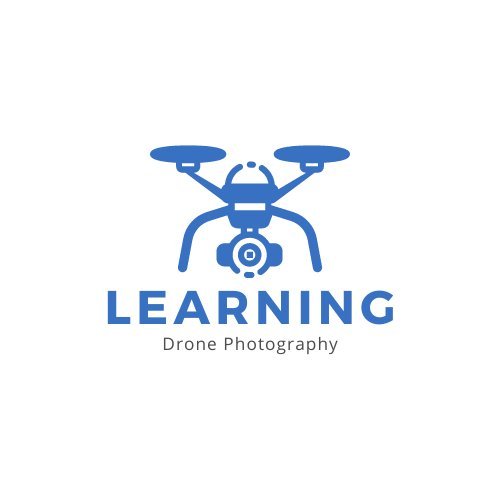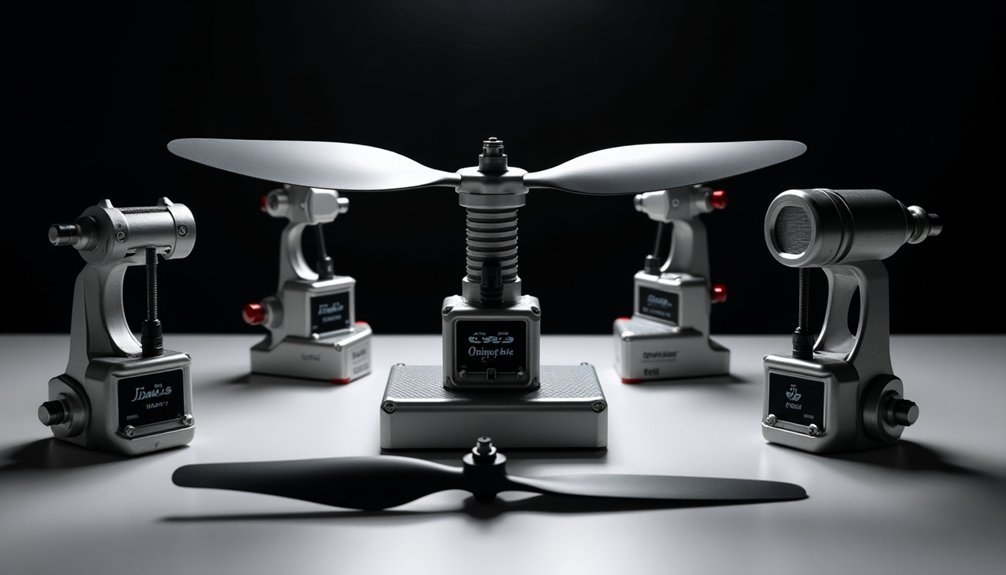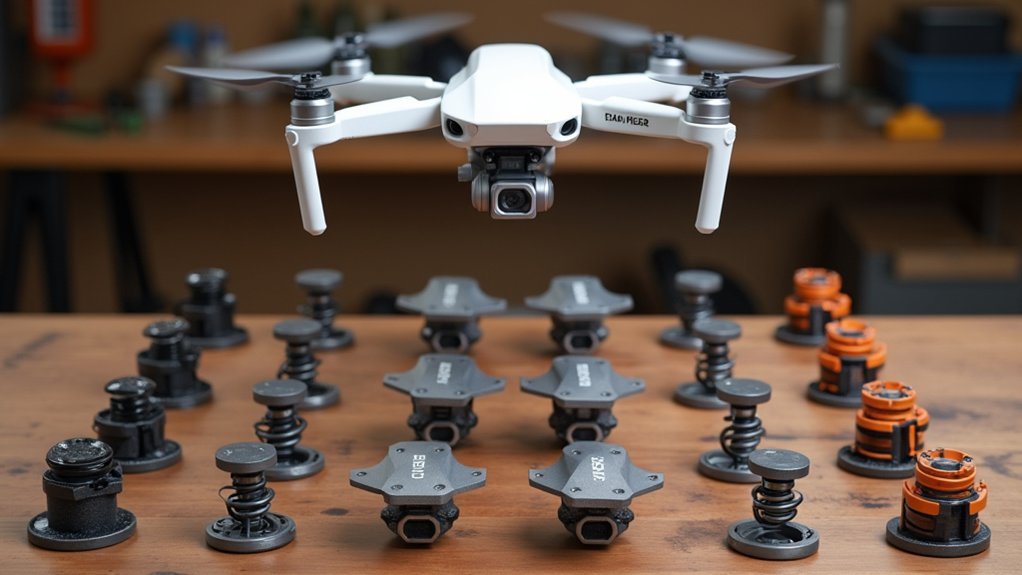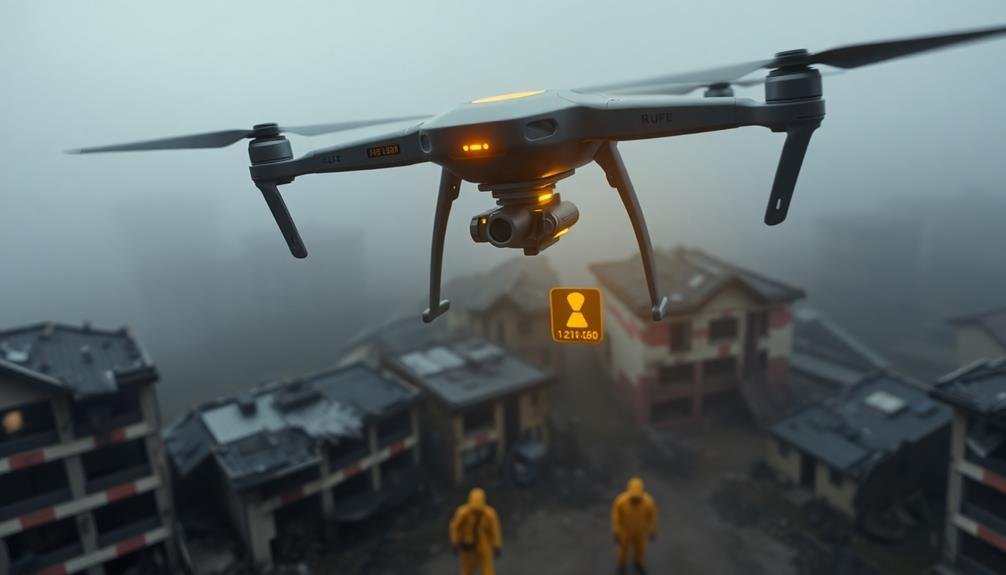You'll find that proper propeller balancing makes all the difference in your RC aircraft's performance. Whether you're flying drones, planes, or helicopters, an unbalanced prop can lead to vibration issues, reduced flight time, and potential damage to your expensive electronics. In our thorough testing of 2025's top balancing tools, we've identified six standout options that'll help you achieve that perfect equilibrium and keep your aircraft running smoothly. Let's uncover which tool best suits your needs.
Du-Bro Tru-Spin Prop Balancer for Props, Tires, and Rotors
The Du-Bro Tru-Spin stands out as a versatile balancing solution for both beginners and experienced hobbyists who need precision across multiple applications. You'll appreciate its friction-free aluminum wheels and adjustable side plates that accommodate props, tires, rotors, and even antique fan blades.
With a 4.4-star rating from over 900 users, this tool delivers noticeable improvements in flight performance by reducing vibrations and extending battery life. While some users note minor assembly challenges, Du-Bro's responsive customer service guarantees you'll get support when needed. The specially designed locking cone centers props securely, though you might need extra materials like tape for weight adjustments.
Best For: RC enthusiasts, drone pilots, and hobbyists seeking a precise balancing tool for props, rotors, and other rotating components who want to improve performance and reduce vibrations.
Pros:
- Versatile design works with multiple applications including props, tires, rotors, and even antique fan blades
- High-precision aluminum wheels with virtually friction-free operation for accurate balancing
- Strong customer satisfaction with 4.4/5 stars from 937 ratings and reliable customer service
Cons:
- Assembly can be challenging for some users and requires careful attention
- Additional materials like tape may be needed for weight adjustments
- Some concerns about the durability of the locking mechanism over extended use
Toyvian Propeller Wrench Tool for Quadcopters
Drone enthusiasts seeking a reliable propeller removal solution will find the Toyvian Propeller Wrench Tool invaluable for their Hubsan X4 quadcopters. This silver aluminum alloy U-wrench fits multiple X4 models, including H107, H107L, H107C, and H107D.
You'll appreciate its simple, practical design for quick propeller disassembly, especially on whoop models. While it works effectively with shaft-mounted props, you might face challenges with props that wrap around the bell, like on tinyhawks. The professional-grade metal construction guarantees durability, though users with larger hands may find the grip slightly uncomfortable. Keep in mind it's specifically designed for Hubsan X4 series and won't work with all quadcopter models.
Best For: Hubsan X4 quadcopter owners who need a dedicated tool for quick and efficient propeller removal and maintenance.
Pros:
- Durable aluminum alloy construction ensures long-lasting performance
- Simple and practical design makes propeller removal straightforward
- Compatible with multiple Hubsan X4 models including H107, H107L, H107C, and H107D
Cons:
- Limited compatibility – only works with specific Hubsan X4 models
- May be uncomfortable for users with larger hands
- Not effective with propellers that wrap around the bell housing
Magnetic RC Propeller Blade Balancer Tool
Magnetic levitation technology makes this RC propeller balancer an ideal choice for serious hobbyists who need precise dynamic balance detection. You'll appreciate its versatility, as it handles any multirotor propeller with 2.0-5.0mm blade holes and works with Trex 250-700 RC helicopters.
The carbon fiber and metal construction guarantees durability, while the zero-friction maglev system delivers exceptional accuracy. At just 3.2 ounces and compact dimensions of 3x3x2 inches, it's perfectly portable. Though it requires assembly, users have awarded it perfect 5-star ratings, confirming its effectiveness for both helicopter blades and drone propellers.
Best For: RC enthusiasts and hobbyists seeking professional-grade propeller balancing for their multirotor drones and helicopters who need precise, friction-free measurements.
Pros:
- Magnetic levitation system provides extremely accurate balance detection with zero friction
- Versatile compatibility with multiple blade sizes (2.0-5.0mm) and helicopter types
- Durable construction using carbon fiber and metal materials
Cons:
- Requires assembly which may be challenging for some users
- Higher price point compared to traditional balancing tools
- Limited customer reviews available to verify long-term reliability
Tire Balancing Beads – Installation/Applicator Kit
Modern DIY enthusiasts can save hundreds on tire maintenance with a thorough balancing bead installation kit. You'll get all essential components, including a valve core removal tool, applicator bottle, and tube for seamless ceramic bead installation.
The kit works effectively on various tire sizes, from 17.5 trailer tires to 22.5 inch truck tires. While installation requires careful attention – don't fill the bottle more than 3/4 full and shake vigorously while squeezing – it's often easier than removing tire beads manually.
For best results, consider using a vibrator tool if beads become stubborn during installation. Though some users face initial challenges, proper technique guarantees successful DIY tire balancing.
Best For: DIY auto enthusiasts and vehicle owners looking to save money on professional tire balancing services while maintaining multiple vehicles or trailers.
Pros:
- Complete kit includes all essential tools needed for DIY tire balancing
- Works effectively on multiple tire sizes from 17.5" to 22.5"
- More cost-effective than repeated professional balancing services
Cons:
- Installation can be challenging without proper technique or additional tools
- Some users report difficulty with hose compatibility on conventional tire valves
- Learning curve may require multiple attempts for successful installation
Carbon Fiber Propeller Balancer Tool for RC Aircraft
RC enthusiasts seeking a budget-friendly balancing solution will find the Carbon Fiber Propeller Balancer Tool a practical choice for their aircraft maintenance needs. This maglev-based balancer works with props up to 80 grams and uses a high-performance magnet with a carbon fiber plate for zero-resistance balancing.
While you'll appreciate its effectiveness compared to pricier options, be prepared for some limitations. The weak magnet friction fit and off-center knobs may require modifications like grinding or super glue for better stability. You'll need to balance props individually due to unbalanced holding nuts, and it's best to sand down excess material for improved accuracy.
Best For: Budget-conscious RC hobbyists who need a basic prop balancing tool and are willing to make minor modifications for optimal performance.
Pros:
- Affordable alternative to more expensive prop balancers
- Zero-resistance magnetic levitation balancing system
- Compatible with various prop sizes up to 80 grams
Cons:
- Weak magnet friction fit may cause stability issues
- Off-center knobs can affect balance accuracy
- Requires modifications and adjustments for reliable performance
Precision Prop Balancer with Carbon Fiber Magnetic Levitation
Enthusiasts seeking professional-grade propeller balancing will find the Precision Prop Balancer a game-changing solution. Its N45 high-performance magnets create a magnetic levitation system that allows for zero-resistance rotation, helping you achieve ideal balance for your multicopter props.
The carbon fiber mounting plate combines lightweight durability with strength, while the magnetic levitation design eliminates traditional friction points. However, you'll want to take into account mixed user feedback, as some pilots report inconsistent performance compared to higher-end alternatives. Despite its innovative approach, this balancer might not deliver the precision that its name suggests for every user.
Best For: Hobby drone enthusiasts and multicopter pilots seeking an affordable magnetic levitation balancing solution for their propellers.
Pros:
- Carbon fiber construction provides excellent durability while maintaining lightweight properties
- Magnetic levitation system eliminates traditional friction points for smoother operation
- N45 high-performance magnets enable stable levitation for balance testing
Cons:
- Mixed user reviews suggest inconsistent performance compared to premium alternatives
- May not provide the precision level suggested by its marketing claims
- Some users report issues with balance and friction despite magnetic levitation design
Factors to Consider When Choosing Propeller Balancing Tools
When you're selecting a propeller balancing tool, you'll want to evaluate essential features like accuracy ratings and the tool's build quality, including whether it's crafted from durable materials like steel or carbon fiber. The tool's weight capacity and physical dimensions must match your specific prop sizes, while quick assembly and user-friendly design can save you valuable maintenance time. Make sure to verify compatibility with your propeller types, as some balancers work better with specific materials or prop configurations.
Accuracy and Precision Levels
Because precision in propeller balancing can make or break your aircraft's performance, choosing tools with high accuracy levels should be your top priority. Look for balancers that feature magnetic levitation technology, as their zero-friction design delivers superior measurement accuracy and smoother rotation during testing.
You'll want to pay attention to the construction quality, particularly carbon fiber components and high-grade magnets, as these materials guarantee consistent readings over time. If you're considering a tool that requires assembly, make sure you're comfortable with detailed setup procedures – incorrect assembly can compromise accuracy. Additionally, opt for balancers that allow you to work with one propeller at a time, as this method prevents measurement errors that can occur when multiple props are balanced simultaneously.
Material and Build Quality
The materials and engineering quality of your propeller balancing tools directly impact their longevity and reliability. You'll want to look for tools made from premium materials like carbon fiber or aluminum alloy, which offer an ideal balance of strength and lightweight properties.
Pay attention to the quality of magnetic components, particularly N45 high-performance magnets, as they're vital for achieving stable levitation and zero-resistance rotation. Tools featuring precision-engineered elements, such as friction-free aluminum wheels and robust locking mechanisms, will provide more accurate balancing results. Watch out for signs of poor manufacturing, like weak magnet friction fits or misaligned parts, as these issues can compromise your balancing accuracy. Remember that superior build quality isn't just about durability—it's essential for maintaining consistent performance throughout the tool's lifetime.
Size and Weight Capacity
Selecting the right size and weight capacity stands as an essential decision point for propeller balancing tools.
You'll need to verify that your propeller's blade holes match the tool's specifications, typically ranging from 2.0 to 5.0mm. Don't overlook the weight limit – most balancers handle props up to 80 grams, but if you're working with larger props, you'll need a tool with higher capacity.
Consider the balancer's physical dimensions carefully. While compact tools offer convenient storage and handling, larger models might provide better stability during use. If you frequently switch between different prop sizes, look for a tool that's easy to assemble and disassemble. This flexibility will save you time and frustration as you work with various propeller types.
Ease of Assembly
Once you've determined the right size specifications for your propeller balancing needs, assembly complexity becomes your next key consideration. Many modern balancing tools like the Du-Bro Tru-Spin come with detailed instructions that'll help you set up quickly and efficiently.
You'll find that tools with simpler designs, such as those using basic magnetic levitation or U-wrench mechanisms, typically offer the easiest assembly process. When shopping, look for products with fewer moving parts, as they're generally faster to put together and require less troubleshooting. While some users report occasional challenges with certain models, most current balancing tools are designed for straightforward assembly. If you're new to RC hobbies, you might want to start with a less complex tool until you've gained more experience with propeller balancing.
Compatibility With Props
Proper compatibility stands as the cornerstone of effective propeller balancing. When choosing your balancing tool, you'll need to verify it can handle various prop types, from model airplane propellers to drone and helicopter blades.
Check the tool's specifications for supported hole diameters, typically ranging from 2.0 to 5.0mm, to ascertain it'll work with your props. Some balancers are brand-specific, so you'll want to confirm whether the tool matches your particular models. Pay attention to the balancer's construction materials, as certain props require specific materials like carbon fiber or aluminum to prevent damage during the balancing process. Look for tools that come with detailed compatibility guidelines and clear instructions to help you determine if they'll work with your propeller collection.
Price Vs Performance Value
How much should you invest in a propeller balancing tool? While you'll find options ranging from $10 to over $100, your choice should align with your long-term needs and flying frequency. Premium balancers with magnetic levitation and carbon fiber components deliver superior precision that directly impacts your drone's performance.
Don't let the lower price tags of budget balancers fool you. These cheaper alternatives often lack durability and precision, leading to frequent replacements that'll cost you more over time. Higher-end models consistently earn better user ratings because they effectively reduce motor wear and extend battery life. When you factor in the improved flight performance and reduced maintenance costs, spending more upfront on a quality balancer typically proves to be a smarter investment for serious drone enthusiasts.
Frequently Asked Questions
How Often Should I Rebalance My Propellers?
You should rebalance your propellers every 25-30 flight hours or when you notice unusual vibrations. If you've hit something or had a rough landing, it's smart to check your prop balance immediately.
Can I Use the Same Balancer for Different Propeller Materials?
Yes, you can use the same balancer for different propeller materials like plastic, carbon fiber, or wood. However, you'll need to verify your balancer has the right mounting adapters for various prop sizes.
What Causes Propellers to Become Unbalanced Over Time?
Your propellers can become unbalanced due to normal wear and tear, impacts with debris, UV damage, temperature changes, and moisture exposure. Minor chips, bends, or material deterioration will affect their balance over time.
Are Magnetic Balancers More Accurate Than Mechanical Ones?
You'll find magnetic balancers typically offer better accuracy than mechanical ones because they're less affected by external vibrations and friction. They can detect even the slightest imbalances that mechanical systems might miss.
Do Weather Conditions Affect Propeller Balance Readings?
Yes, weather conditions can affect your propeller balance readings. You'll notice that wind, humidity, and temperature changes can impact measurements. It's best to balance props in a controlled, indoor environment for accuracy.
In Summary
You'll find that investing in a quality propeller balancing tool is vital for ideal RC aircraft performance. Whether you've chosen the versatile Du-Bro Tru-Spin or the high-tech Magnetic Blade Balancer, proper balancing will reduce vibration and extend your motor's life. Remember to take into account your specific needs, budget, and compatibility when selecting from these top 2025 options. Don't compromise on this essential maintenance tool.

As educators and advocates for responsible drone use, we’re committed to sharing our knowledge and expertise with aspiring aerial photographers.




Leave a Reply